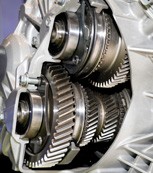
In any vehicle application the transmissions play a key role to ensure the availability and the usability of the power generated by the engine. Recently, transmission oils have undergone deep changes intended to guarantee the operation of the transmissions in more and more difficult conditions in terms of temperature and load on the gears. The tendency to reduce the size and weight of gear boxes and to try to reduce internal friction of the transmissions to minimize dissipated power, has caused the birth of a generation of high performing transmission oils with drain oil intervals that are always longer.
Eni is present in this sector with a complete products range including lubricants suited to the large loads of the operator machines and products for the most modern automatic and automated gears in automobiles, lubricants for agricultural machine transmissions and oils able to work in the motorcycles gears and torque converters of modern scooters. Automobile transmission oils include manual transmission oils and automatic transmission oils (ATF - Automatic Transmission Fluid) and differential gear oils.
The performance of transmission oils has been standardized since the 1950s with the introduction of MIL-L-2105 (American military specification) and, only at the beginning of the 1960s by the API (American Petroleum Institute), with the introduction of the GL (Gear Lubricant) specifications. There are no European specifications: the builders tend to use internal specifications, based on tests performed on original parts.
In relation to the tendency of the builders to consider transmission oil as fill-for-life oils the technology is evolving towards synthetic based formulas.